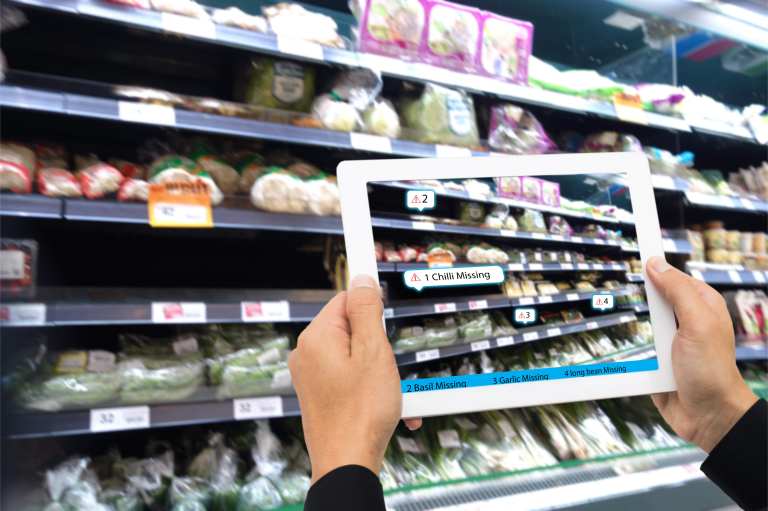
The grocery battles are heating up in retail, and that is sparking innovation and could lead to even more disruption.
Some of that was on display at the NRF retail show in New York City earlier this week. According to an account from ProgressiveGrocer.com, for instance, a company displayed a “digital robot that lives in a rail attached on one top shelf per aisle that can help with out-of-stock detection and planogram compliance in an unobtrusive manner, nearly invisible to the shopper.” Another example of grocery innovation at the show involved “a small autonomous drone using computer vision and artificial intelligence (AI) to tackle on-shelf inventory visibility. It visually scans and recognizes the products on a shelf, knowing when items are facing the wrong direction or in the wrong spot.”
Grocery checkout is another area of change, as shown at the NRF show, with the report describing “interfaces on the cart that can handle scanning of items and, more exciting, visually recognize what’s going into shoppers’ carts. This eliminates the need for going through a checkout, and the screens can also recommend like products or promotions during the shopping trip.”
Walmart’s Big Move
The NRF show, which ended Tuesday (Jan. 14), is not the only place where grocery store innovation is coming from. Big retail chains are part of those efforts, and that includes Walmart.
It is aiming to solidify its position as America’s largest grocer with a grocery-picking robot called Alphabot that is said to pick, pack and deliver orders fast, the company announced in early January.
Automated grocery systems like Alphabot can reportedly pick and pack orders an estimated 10 times faster than a person, which could increase order capacity as demand grows for online grocery services. Alphabot, which was developed solely for Walmart by startup Alert Innovation, uses autonomous carts to pick orders for groceries purchased online. A Walmart associate then checks, bags and delivers the final orders.
The technology was secretly being piloted at a Walmart Supercenter in Salem, New Hampshire, which will serve as Alphabot’s home base. The system will repeatedly be analyzed for improvements before launching nationwide. “By assembling and delivering orders to associates, Alphabot is streamlining the order process, allowing associates to do their jobs with greater speed and efficiency,” said Brian Roth, senior manager of pickup automation and digital operations for Walmart U.S.
Roth believes that Alphabot could inherently transform Walmart’s eGrocery enterprise and “free associates to focus on service and selling, while the technology handles the more mundane, repeatable tasks.”
“This is going to be a transformative impact to Walmart’s supply chain,” Roth said. “Alphabot is what we think of as micro-fulfillment — an inventive merger of eCommerce and brick-and-mortar methods.”
Consumer Needs
The system uses fully autonomous bots that operate on three axes of motion, with the ability to move items horizontally and vertically without lifts or conveyors. Alphabot also continually shares order information, and as its learning advances, “stocking will get more intelligent,” said Roth.
“We never want to be in a position to tell an online grocery customer they can’t have an item,” he said. “We’ll be able to look at datasets and fairly say, ‘these two brands of pasta are typically bought together,’ or ‘here’s an item a consumer buys often,’ and use that information to make more informed substitutions.”
Supermarket sales make up 56 percent of Walmart’s total U.S. revenue, but the grocery space is becoming crowded, with increased competition from Amazon, Costco, Kroger and others looking to tap into online food shopping.
Indeed, as all these recent developments show, numerous technologies and various consumer desires are combining to bring more digital power to the once mundane practice of grocery shopping.